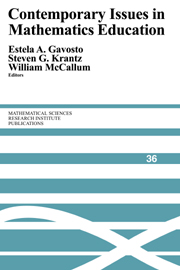Book contents
Different Teaching Methods
Published online by Cambridge University Press: 27 June 2025
Summary
Members: Greg Baker, David Epstein, Ted Gamelin, Sid Graham (Reporter), Ole Hald (Discussion Leader), Delphine Hwang, Suzanne Lewis, Randy Mc- Carthy, Brad Shelton, John Sims, Robert Underwood
Questions for Day 1
• What is your favorite teaching method? (Standard lecture method, collaborative learning, labs, etc.)
• What experiments have you tried in order to improve your teaching methodology? (Getting students actively involved in the lecture, group work, lab projects, using technology, etc.)
• What did you want to achieve with your experiment? Did you achieve it? Were there any unexpected results?
Questions for Day 2
• What goals would you set for alternative teaching methods? (For example, getting students to read, write, think for themselves, take responsibility for their work.)
• What strategies do you recommend to achieve these goals? What obstacles stand in the way?
The participants in this working group exchanged ideas on teaching techniques that they either use regularly or with which they have experimented. Over time, enthusiastic mathematics instructors have attempted various new and old teaching techniques. The wheel is constantly being reinvented. Nevertheless, the characteristics of the body of students taking calculus are constantly changing, teaching resources are changing, and teaching techniques require constant experimentation and adaptation to new circumstances. It is a worthwhile exercise to compile an assortment of teaching techniques, and to describe their assets and pitfalls. We begin here to create such a collection.
We describe here several of the techniques that various committee members have used in recent years. The techniques we list are all designed to work in large lecture sections; many of the techniques are adaptable to the small class format as well.
Information
- Type
- Chapter
- Information
- Contemporary Issues in Mathematics Education , pp. 147 - 150Publisher: Cambridge University PressPrint publication year: 1999
